RESEARCH
Standard deviation of anthropometric Z-scores as a data quality assessment tool using the 2006 WHO growth standards: a cross country analysis
Pertinence de lutilisation de lécart-type des valeurs z anthropométriques comme outil délevation de la qualité des donées daprès les normes de croissance 2006 de lOMS : analyse transversale par pays
La desviación estándar de los valores Z antropométricos como instrumento de evaluación de la calidad de los datos a partir de los patrones de crecimiento de la OMS de 2006: análisis interpaíses
Zuguo Mei1; Laurence M Grummer-Strawn
Maternal and Child Nutrition Branch, Division of Nutrition and Physical Activity, Centers for Disease Control and Prevention, Mailstop K-25, 4770 Buford Highway, Atlanta, GA 30341-3724, USA
ABSTRACT
OBJECTIVE: Height- and weight-based anthropometric indicators are used worldwide to characterize the nutritional status of populations. Based on the 1978 WHO/National Center for Health Statistics (NCHS) growth reference, the World Health Organization has previously indicated that the standard deviation (SD) of Z-scores of these indicators is relatively constant across populations, irrespective of nutritional status. As such, the SD of Z-scores can be used as quality indicators for anthropometric data. In 2006, WHO published new growth standards. Here, we aim to assess whether the SD of height- and weight-based Z-score indicators from the 2006 WHO growth standards can still be used to assess data quality.
METHODS: We examined data on children aged 059 months from 51 Demographic and Health Surveys (DHS) in 34 developing countries. We used 2006 growth standards to assign height-for-age Z-scores (HAZ), weight-for-age Z-scores (WAZ), weight-for-height Z-scores (WHZ) and body-mass-index-for-age Z-scores (BMIZ). We also did a stratified analysis by age group.
FINDINGS: The SD for all four indicators were independent of their respective mean Z-scores across countries. Overall, the 5th and 95th percentiles of the SD were 1.35 and 1.95 for HAZ, 1.17 and 1.46 for WAZ, 1.08 and 1.50 for WHZ and 1.08 and 1.55 for BMIZ.
CONCLUSION: Our results concur with the WHO assertion that SD is in a relatively small range for each indicator irrespective of where the Z-score mean lies, and support the use of SD as a quality indicator for anthropometric data. However, the ranges of SDs for all four indicators analysed were consistently wider than those published previously by WHO.
RÉSUMÉ
OBJETIF: Dans le monde entier, on utilise des indicateurs anthropométriques liés à la taille et au poids pour caractériser létat nutritionnel des populations. En sappuyant sur les données de référence pour la croissance OMS/NCHS (National Center for Health Statistics) de 1978, lOrganisation mondiale de la Santé a dans le passé affirmé que lécart-type des valeurs de z pour ces indicateurs était relativement constant parmi les populations, quel que soit leur état nutritionnel. En tant que tel, lécart-type des valeurs de z peut être utilisé comme indicateur de qualité pour les données anthropométriques. En 2006, lOMS a publié de nouvelles normes de croissance. Nous nous sommes attachés dans cette étude à évaluer si les écarts-types des indicateurs correspondant aux valeurs du z pour les rapports taille/âge et poids/âge selon les normes de croissance 2006 de lOMS étaient encore utilisables pour évaluer la qualité des données.
MÉTHODES: Nous avons analysé des données concernant des enfants de 0 à 59 mois et tirées de 51 enquêtes démographiques et de santé (DHS), menées dans 34 pays en développement. Nous avons fait appel aux normes de croissance 2006 de lOMS pour affecter des valeurs du z pour les rapports taille/âge, poids/âge et poids/taille et pour lindice de masse corporelle en fonction de lâge. Nous avons également réalisé une analyse stratifiée par tranches dâge.
RÉSULTATS: Les écarts-types pour les quatre indicateurs se sont révélés indépendants des moyennes nationales des valeurs du z correspondantes. Globalement, le 5e et le 95e percentiles de lécart-type étaient respectivement de 1,35 et de 1,95 pour la valeur du z du rapport taille/âge , de 1,17 et de 1,46 pour la valeur du z du rapport poids/âge, de 1,08 et de 1,55 pour la valeur du z du rapport poids/taille et de 1,55 pour la valeur du z de lindice de masse corporelle.
CONCLUSION: Nos résultats confortent laffirmation de lOMS selon laquelle lécart-type serait compris dans une plage relativement étroite pour chaque indicateur, indépendamment de la zone où se situe la moyenne du z correspondant, ce qui confirme la pertinence de son utilisation comme indicateur de qualité pour les données anthropométriques. Cependant, les plages dencadrement trouvées pour les écarts-types des quatre indicateurs anthropométriques sont considérablement plus larges que celles publiées auparavant par lOMS.
RESUMEN
OBJETIVO: Los indicadores antropométricos basados en la talla y el peso son utilizados en todo el mundo para caracterizar el estado nutricional de las poblaciones. Basándose en la referencia de crecimiento OMS/Centro Nacional de Estadísticas Sanitarias (NCHS) de 1978, la Organización Mundial de la Salud (OMS) ha señalado anteriormente que la desviación estándar (DE) de la Z de esos indicadores es relativamente constante entre las poblaciones, con independencia de su estado nutricional. Las DE de los valores Z pueden utilizarse por tanto como indicadores de la calidad de los datos antropométricos. En 2006 la OMS publicó sus nuevos patrones de crecimiento. En este trabajo hemos intentado determinar si la DE de los indicadores Z basados en la talla y el peso de los patrones de crecimiento OMS de 2006 se pueden seguir utilizando para evaluar la calidad de los datos.
MÉTODOS: Examinamos los datos referentes a niños de 0 a 59 meses de 51 Encuestas de Demografía y Salud (EDS) llevadas a cabo en 34 países en desarrollo. Utilizamos los patrones de crecimiento de 2006 para asignar valores Z de la talla para la edad (ZTE), Z del peso para la edad (ZPE), Z del peso para la talla (ZPT) y Z del índice de masa corporal para la edad (ZIMC), y realizamos además un análisis estratificado por grupos de edad.
RESULTADOS: Las DE de los cuatro indicadores fueron independientes de sus respectivas Z medias en todos los países. Globalmente, los percentiles 5 y 95 de la DE fueron de 1,35 y de 1,95 para la ZTE, 1,17 y 1,46 para la ZPE, 1,08 y 1,50 para la ZPT, y 1,08 y 1,55 para la ZIMC.
CONCLUSIÓN: Nuestros resultados corroboran la afirmación de la OMS de que la DE representa un intervalo relativamente pequeño para cada indicador con independencia de la posición de la Z media, lo que avala su uso como indicador de la calidad de los datos antropométricos. Sin embargo, los intervalos de las DE de los cuatro indicadores de nuestro análisis fueron siempre mayores que los publicados anteriormente por la OMS.

Introduction
Nutritional status, especially in children, has been widely and successfully assessed by anthropometric measures in both developing and developed countries.1 Height and weight are the most commonly used measures, not only because they are rapid and inexpensive to obtain, but also because they are easy to use. Once a childs height and weight have been correctly measured and their age has been recorded, a clinician or researcher can assess the childs growth and general nutritional status by using a standardized age- and sex-specific growth reference to calculate height-for-age Z-scores (HAZ), weight-for-age Z-scores (WAZ), weight-for-height Z-scores (WHZ) and body-mass-index-for-age Z-scores (BMIZ).
An international reference is useful since the growth in height and weight of well fed, healthy children under 5 years of age from different ethnic backgrounds and different continents is reasonably similar.24 In April 2006, the World Health Organization released new global child growth standards for infants and children up to the age of 5 years. These new standards were developed in accordance with the idea that children, born in any region of the world and given an optimum start in life, all have the potential to grow and develop to within the same range of height and weight for age. The new WHO child growth standards, which will be used worldwide, provide a common basis for the analysis of growth data.5, 6
The Z-score system expresses anthropometric values as several standard deviations (SDs) below or above the reference mean or median value. Because the Z-score scale is linear, summary statistics such as means, SDs and standard errors can be computed from Z-score values. Z-score summary statistics are also helpful for grouping growth data by age and sex. The summary statistics can be compared with the reference, which has an expected mean Z-score of 0 and a SD of 1.0 for all normalized growth indices.1 On the basis of the 1978 WHO/National Center for Health Statistics (NCHS) growth reference, WHO has previously indicated that the SD of Z-scores of these indicators is reasonably constant across populations, irrespective of nutritional status, and thus can be used to assess the quality of anthropometric data.1 However, there has been no evaluation of whether these Z-score ranges still apply to data attained from application of the 2006 WHO growth standards.
For this analysis, we used all available Demographic and Health Survey (DHS) data that have height and weight measurements for children from birth to 59 months of age to assess whether the SD of height- and weight-based Z-score indicators derived from the 2006 WHO growth standards can still be used as data quality indicators.
Methods
The DHS are nationally representative surveys with large sample sizes. Supported by the United States Agency for International Development (USAID), the surveys provide data on a wide range of monitoring and impact evaluation indicators in the areas of population, health and nutrition of women and children in developing countries.
The surveys are based on household interviews of women of childbearing age, and they record standardized anthropometric measurements and some biochemical measurements. Standard core questionnaires are used for all DHS surveys to obtain information about respondents backgrounds, the children they have given birth to, their knowledge and use of family planning methods, the health of their children, their reproductive health and other issues helpful to policy-makers and administrators in health and family planning. Results are comparable between countries because the surveys use standard questionnaire modules and standardized sampling procedures, fieldwork methods (i.e. similar schedules of field work, standardized training for each survey worker, the same number of survey workers and type of equipment for each survey team) and data processing techniques. Four rounds of surveys have been completed to date: DHS I (19841989), DHS II (19881993), DHS III (19921997) and DHS+ (19972003). Over the past 20 years, the DHS project has coordinated surveys in more than 70 countries throughout sub-Saharan Africa, north Africa, Asia, Latin America and the Caribbean, and parts of Europe. Details of the DHS survey design and methodology have been published elsewhere.712
According to the protocols used by the DHS, for children younger than 60 months of age, height or length is measured to the nearest 0.1 cm. A measuring board is used to measure the childs recumbent length if the childs age is younger than 24 months; standing height is measured for children 24 months or older. Weight is measured to the nearest 0.1 kg on a paediatric scale or other beam balance scale. All survey team members receive standardized training on how to weigh and measure children. The protocol requires that two measurements of a childs length or height agree within 0.1 cm, and two readings of weight agree within 0.1 kg.10,11 These measurement instructions are based, with some alteration, on the United Nations manual on how to weigh and measure children.13 All records are entered onto a standardized paper form or into an automated computer system in the field. After the records are computerized at the country level, they are transferred to Macro International Incorporated, an Opinion Research Corporation company (ORC Macro), for inclusion in the DHS database. For our analysis, all Z-scores HAZ, WAZ, WHZ and BMIZ were recalculated using the 2006 WHO growth standards with a SAS Macro program.14
Altogether, 94 surveys from 46 countries were available from the DHS website (http://www.measuredhs.com). Of these 94, we excluded 11 surveys that had missing anthropometric data and 32 surveys that did not collect data for children aged 059 months. The final sample for this analysis was from 51 DHS surveys representing 34 developing countries (Table 1).
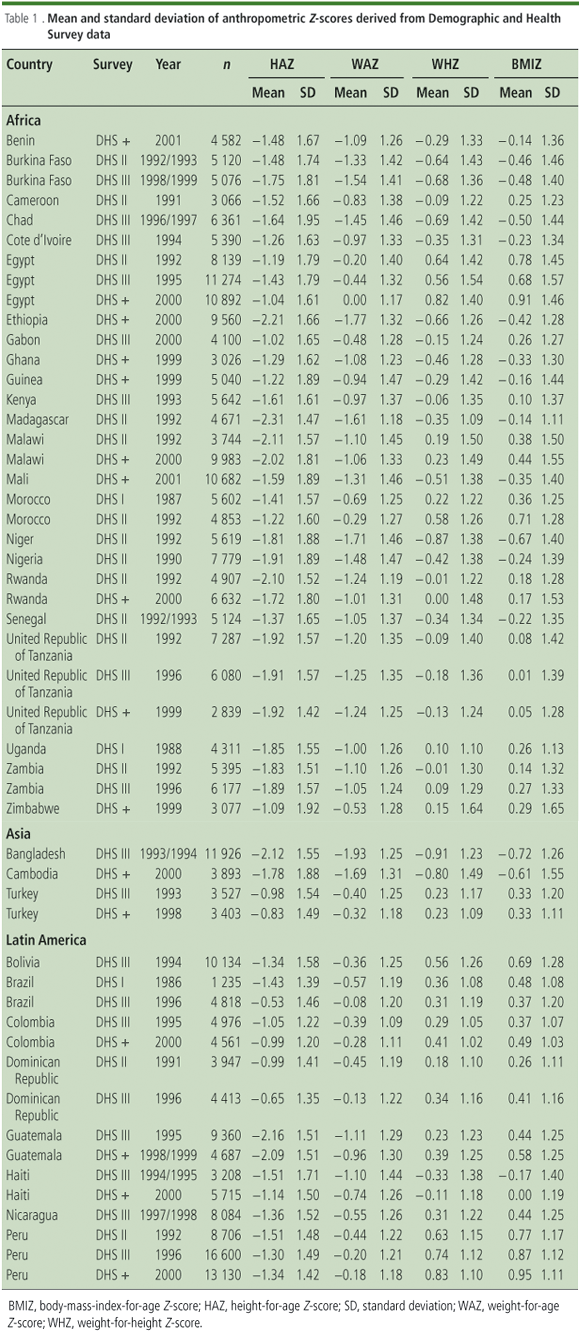
In our final sample for each DHS survey, we excluded children without data on height, weight, age or sex. We used the new cut-offs recommended by the WHO for data exclusion.5 Thus, data were excluded if a childs HAZ was below 6 or above +6, WAZ was below 6 or above +5, WHZ was below 5 or above +5, or BMIZ was below 5 or above +5, because these extreme values were most likely a result of errors in measurement or data entry.5
In our analysis, we calculated the Z-score means and SDs of the four nutritional indicators (HAZ, WAZ, WHZ and BMIZ) for each survey and summarized them by region (Africa, Asia and Latin America). Then we repeated the analysis by age group (035 months and 3659 months). All data were analysed with SAS software version 8.2,15 and the original sample weights for each survey were applied to all the results.
Results
Of the 51 DHS surveys, 32 were from 23 African countries, four were from three Asian countries and 15 were from eight Latin American countries (Table 1). Z-score means and SDs of height-for- age, weight-for-age, weight-for-height, and body-mass-index-for-age are summarized in Table 1 and also shown in Fig. 1 to Fig. 4, respectively. For all four indicators, Z-score means in Latin American countries were generally higher than in African and Asian countries (Fig. 1, to Fig. 4 and Table 2). However, the SDs for all three indicators were relatively stable and did not vary with the Z-score means.

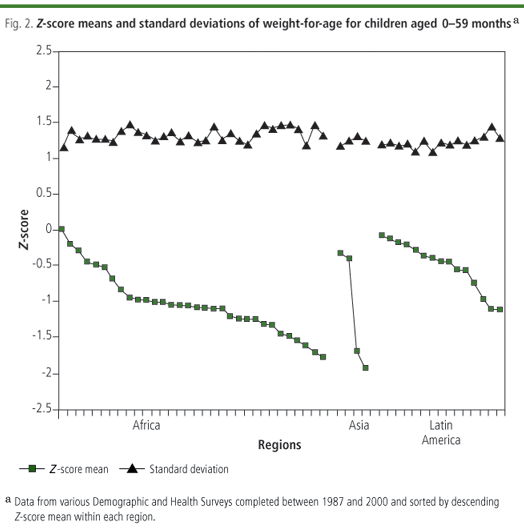
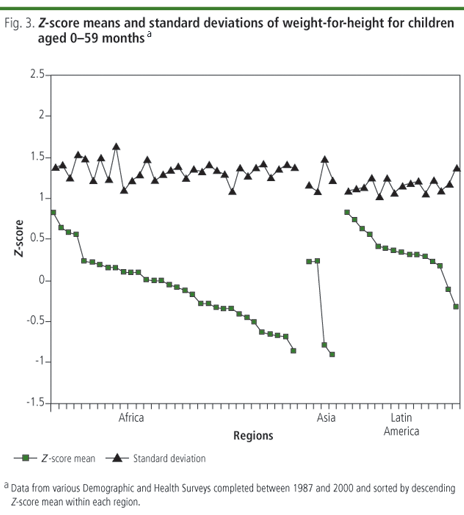
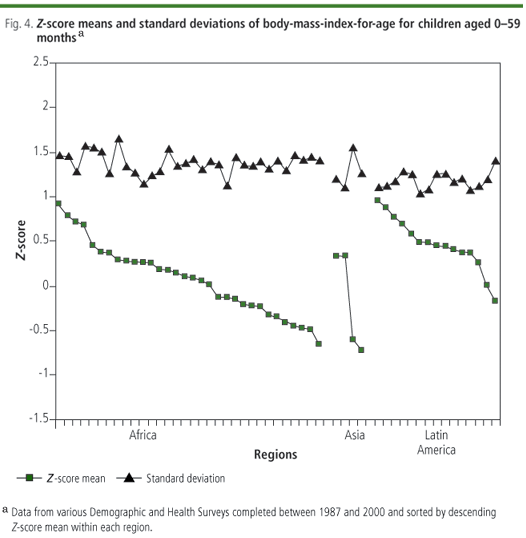
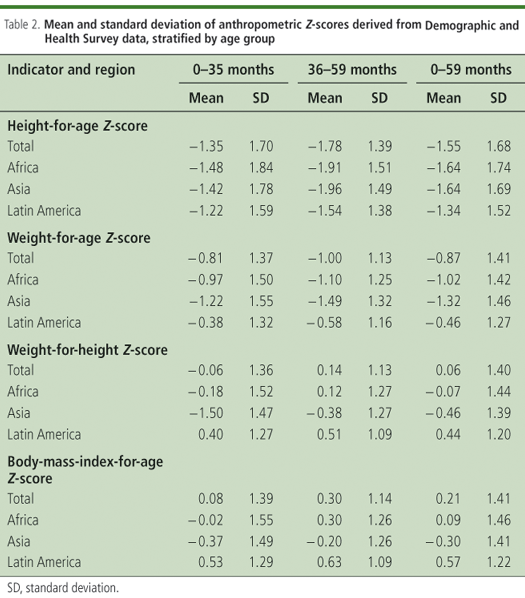
Table 2 shows Z-score means and SDs stratified by age group and region. In general, the Z-score means in older children (3659 months) were lower than those in younger children (035 months), but the SDs in older children were smaller than those in younger children. These findings were true for all four indicators and in all three regions.
For children aged 059 months, the 5th and 95th percentiles of the SDs were 1.35 and 1.95 for HAZ, 1.17 and 1.46 for WAZ, 1.08 and 1.50 for WHZ, and 1.08 and 1.55 for BMIZ (Table 3). The ranges of SDs in children in the younger age group (035 months) were much wider than those of children in the older age group (3659 months). For children aged 035 months, the 5th and 95th percentiles of the SDs were 1.46 and 2.03 for HAZ, 1.23 and 1.56 for WAZ, 1.13 and 1.62 for WHZ, and 1.15 and 1.66 for BMIZ. For children aged 3659 months, they were 1.16 and 1.67 for HAZ, 1.02 and 1.29 for WAZ, 0.94 and 1.33 for WHZ, and 0.95 and 1.36 for BMIZ.
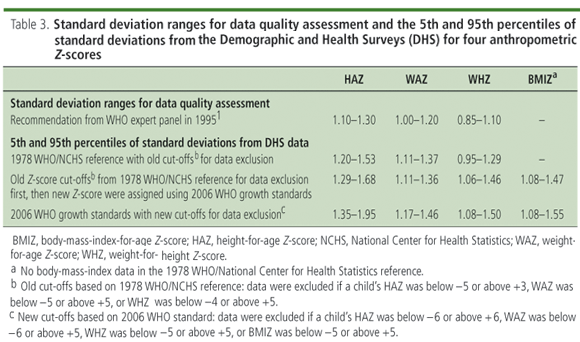
Discussion
Height- and weight-based anthropometric measurement is an excellent tool to gauge general nutritional status in a population. However, informative assessments of nutritional status rely on the data being of high quality. There are several ways to evaluate the quality of data for anthropometric indicators, including percentage of missing data, digit preference in recorded measurements, the percentage of measurements that are biologically implausible and the SDs of the Z-scores.1
On the basis of the 1978 WHO/NCHS growth reference, WHO recommended an acceptance range on the SDs for each indicator for data quality assessment.1 Those acceptance ranges were valid only if the same data exclusion criteria recommended by WHO also applied (i.e. data were excluded if a childs HAZ was below 5 or above +3, WAZ was below 5 or above +5, or WHZ was below 4 or above +5).1 When WHO released the new growth standards in April 2006, they recommended new cut-offs for data exclusion based on the 2006 WHO standard (i.e. data were excluded if a childs HAZ was below 6 or above +6, WAZ was below 6 or above +5, WHZ was below 5 or above +5, or BMIZ was below 5 or above +5).5 The new cut-offs for data exclusion for the 2006 WHO standards were wider than those for the old cut-offs for the 1978 WHO/NCHS reference, particularly in height-for-age measurements.
By applying the 2006 WHO growth standards and the new cut-offs for data exclusion, our analysis confirms the WHO assertion that the SD remains in a relatively small range for each indicator, no matter the Z-score mean. This finding suggests the SD of Z-scores could still be used as a data quality indicator for evaluation of anthropometric data. However, the observed ranges of SD for all four indicators from our analysis were consistently wider (especially in the high value of the range for each indicator and in height-for-age measurements) than those recommended by WHO.1
One of the strengths of our analysis is that we have used data from 51 national representative DHS from 34 developing countries with a large number of standardized measurements. However, a potential limitation is that we included only four surveys from three Asian countries and thus may not have fully captured anthropometric status in this region.
To assess whether the wider SDs that we observed in the DHS data were due to the switching of the growth reference from 1978 WHO/NCHS to 2006 WHO or because of the difference in the cut-offs for data exclusion recommended by WHO for each reference, we repeated our analysis, applying both references and cut-offs to the same DHS data we examined. As shown in Table 3, even with the old 1978 WHO/NCHS reference and the old cut-offs, the observed SDs were wider than recommended by WHO in 1995. Using the old cut-offs based on the 1978 WHO/NCHS reference to clean the DHS data first, then assigning new Z-scores using 2006 WHO standards without any data exclusion, we observed SDs for each indicator that were similar to those obtained with use of the old 1978 WHO/NCHS reference with old cut-offs (Table 3). This finding suggests that the wider range of SD values that we observed, using the 2006 WHO standards with the new cut-offs that WHO recommended for data exclusion, were mostly due to the new wider cut-offs for data exclusion proposed by WHO. 
Acknowledgments
We are grateful to Dr Mercedes de Onis for reviewing the document.
Competing interests: None declared.
References
1. Physical status: the use and interpretation of anthropometry. Geneva: WHO; 1995. WHO technical report series.
2. Graitcer PL, Gentry EM. Measuring children: one reference for all. Lancet 1981;2:297-9.
3. Habicht JP, Martorell R, Yarbrough C, Malina RM, Klein RE. Height and weight standards for preschool children. How relevant are ethnic differences in growth potential? Lancet 1974;1:611-4.
4. Martorell R. Child growth retardation: a discussion of its causes and of its relationship to health. In: Blaxter KL, Waterlow JC, eds. Nutritional adaptation in man. London: John Libbey;1985:13-30.
5. WHO child growth standards: length/height-for-age, weight-for-age, weight-for-length, weight-for-height and body mass index-for-age: methods and development. Geneva: WHO; 2006.
6. de Onis M, Garza C, Victora CG, Bhan MK, Norum KR (eds). The WHO Multicentre Growth Reference Study (MGRS): Rationale, planning, and implementation. Food Nutr Bull 2004;25(Suppl 1):S1-89.
7. Lapham RJ, Westoff CF. Demographic and Health Surveys: population and health information for the late 1980s. Popul Index 1986;52:28-34.
8. Model "A" questionnaire with commentary for high contraceptive prevalence countries: MEASURE DHS+ basic documentation number 1. Calverton: ORC Macro; 2002.
9. Model "B" questionnaire with commentary for low contraceptive prevalence countries: MEASURE DHS+ basic documentation number 2. Calverton: ORC Macro; 2002.
10. Interviewers manual for use with model "A" questionnaire for high contraceptive prevalence countries: MEASURE DHS+ basic documentation number 3. Calverton: ORC Macro; 2002.
11. Interviewers manual for use with model "B" questionnaire for low contraceptive prevalence countries: MEASURE DHS+ basic documentation number 4. Calverton: ORC Macro; 2002.
12. Supervisors and editors manual for use with model "A" and "B" questionnaires: MEASURE DHS+ basic documentation number 5. Calverton: ORC Macro; 2002.
13. How to weigh and measure children: assessing the nutritional status of young children in household surveys. New York: UN Department of Technical Co-operation for Development and Statistical Office; 1986.
14. WHO child growth standards SAS macro. Geneva: WHO; 2006. Available from: http://www.who.int/childgrowth/software/readme_sas.pdf
15. SAS/STAT users guide (version 8, 1st ed). Cary: SAS Institute Inc; 1999.
(Submitted: 7 July 2006 Final revised version received: 16 October 2006 Accepted: 20 October 2006)
1 Correspondence to Zuguo Mei (e-mail: zmei@cdc.gov).
